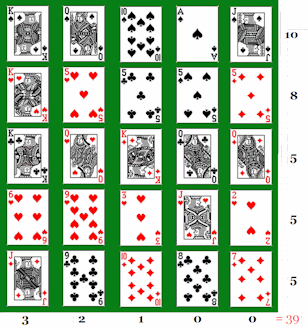Copyright
- Cards
- Three players use a standard 52-card pack; four add a Joker to make 53; two add a Joker but strip the pack to 41 cards by omitting all Twos, Threes and Fours.
- Deal
- Deal 25 cards face down to the table in a square of five rows and five columns. Divide the remaining cards equally among the players by dealing them face down and one at a time.
- Object
- The ultimate aim is produce either the highest or the lowest five-card Poker combination from your hand of cards. This will score according to the total point-value of the 10 Poker combinations formed by the rows and columns of the square when all are exposed.
- Play
- The player at dealer's left begins and all play passes to the left. At each turn you take any face-down card from the square, add it to your hand, and fill the gap with any card from your hand face up. This may be the card just taken.
- Joker (2 or 4 players)
-
- If you hold the Joker, you may on your turn to play take any faced card from the square and leave the Joker face up in its place. This ends your turn.
- If the Joker is lying face up in the square, you may on your turn to play add it to your hand and fill the space with any card from your hand face down.
- If you hold the Joker at end of play, you lose.
- Ending
- Play ceases the moment all 25 cards of the square are face up. The value of the square is then calculated as follows. Each row and each column is considered as a Poker combination and scores 1 for a pair, 2 for two pairs, 3 for a triplet, 5 for a straight, flush or full house, 8 for four of a kind, 10 for a straight flush. A Joker in the square stands for whatever card is needed to make the highest possible combination in one direction, and for whatever other card is needed to make the highest in the other.
- Score
-
2 players : Whichever of you can produce the highest Poker combination
by using any five cards from your hand scores twice the value of the square, and whichever
of you can similarly form the lowest Poker hand (which may be the same person) scores
once the value of the square.
3 players : You each extract from your hand five cards that form either
the highest Poker hand you can make (if you think no one can make a higher) or the lowest
(if you think no one can make a lower). When all are ready, the hands are revealed.
Whoever shows the lowest hand scores once the value of the square; whoever shows the
highest (which may be the same person) scores twice that value; and anyone else scores
nothing.
4 players : You each extract from your hand five cards that form either
the highest Poker hand you can make (if you think no one can make a higher) or the lowest
(if you think no one can make a lower). When all are ready, the hands are revealed.
Whoever shows the lowest hand scores once the value of the square; whoever shows the
highest scores three times that value; whoever shows the second highest scores twice that
value, and the other player scores nothing.
Alternative method :
 If the value of the square is 30 or more, the
player who can make the highest Poker hand scores the value of the square times one
less than the number of players, of the second highest one times less than that, and
so on, the worst hand scoring nothing. If the final value is less than 30, then the
lowest Poker hand wins, and scores are made equivalently, the highest hand scoring zero.
If the value of the square is 30 or more, the
player who can make the highest Poker hand scores the value of the square times one
less than the number of players, of the second highest one times less than that, and
so on, the worst hand scoring nothing. If the final value is less than 30, then the
lowest Poker hand wins, and scores are made equivalently, the highest hand scoring zero.
- Scoring illustration
- The rows from top down illustrate a straight flush (10), four of a kind (8), full house (5), flush (5), and straight (5). The columns from left to right show a triplet (3), two pair (2), one pair (1), nothing (Ace high, five low), nothing else (Queen high, Two low), making a total 39 points.